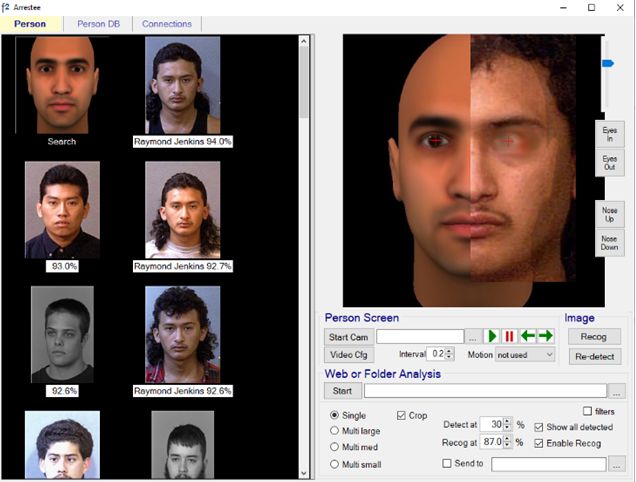Disaster Victim Identification (DVI)
This unique application combines f2’s full and partial face recognition, full and partial tattoo recognition, and corpse identification to facilitate the identification of disaster victims who may well have suffered major injuries to their face and body.
In the event of a major disaster such as an earthquake, tsunami, terrorist event, etc, many bodies will be damaged and difficult or impossible to recognize. To address this f2 DVI combines capabilities developed for a range of real-world identification challenges.
What it Does
f2 DVI is a set of biometric capabilities, many unique, which can be used individually or in combination to help identify damaged bodies. These include:
• Full face recognition
• Partial face recognition
• Full & partial tattoo recognition (including scars and marks where practical)
• Corpse identification, i.e. with both eyes closed
• Drowning victim identification
What it Looks Like:
This screenshot shows a face which has been heavily damaged on one side, leaving the good side to be cropped out and positioned over a generic facial template and then adjusted to fit. The missing eye position is then marked in relation to the good eye, the face area weightings are automatically adjusted, and the search initiated. The top matches in the database are displayed as thumbnail images on the left together with the associated name and Match%. Any match can be magnified for visual confirmation
Example of f2 DVI in Use
f2 DVI was originally developed for the International Committee of the Red Cross (ICRC) to help identify the bodies of migrants who had drowned in the Mediterranean trying to get to Europe, where faces may have been damaged by other boats, marine life, bloating, etc. It enables undamaged areas to be selected and eye locations (which are the critical anchor points for face recognition) to be determined. If both eyes are closed their position can be estimated.
Matching Database
All biometrics require a database of undamaged faces or tattoos to match against. The ICRC’s Trace-the-Face system is a good example, where relatives of missing persons can send in photos of missing relatives to match against this.
Training on Capturing Quality Images
This is particularly important with shots of partial and dead faces, where less information is available to be used compared with full faces. Well-lit and positioned faces/bodies are critical to successful identification. f2 DVI offers online training sessions provided by experienced facial identification experts, on how to optimise body/face position and environmental factors to maximise matching performance.
Background & System Requirements
The Face Forensics team has over 20 years’ experience in developing advanced biometric technologies and implementing them in conjunction with partners around the world.
The f2 DVI suite is available as a stand-alone/networked application, as a .Net SDK, and as a web service. It runs under Windows 10/11 on SQL Server databases. There’s no limit to the number of records/faces that can be held, or number of databases that can be searched.
If databases containing victims’ undamaged faces exist, f2 DVI can map on to them. If not, the software provided includes a copy of Microsoft SQL Server Express and a demonstration database where the demo records can later be deleted and your own records easily added.
f2 DVI is straightforward to install and test, and can be downloaded for evaluation for 30 days at no charge. To be ready for a disaster an annual licence is provided for up to 10,000 faces. This can be used for testing and training and will be ready for operational use when a disaster occurs. For larger numbers of victims additional capacity can be ordered as required. There’s no ceiling to the number of victim images that can be held in the database being searched.

Partial face with remaining eye closed, positioned on a generic template. Top match against a 5000 face database